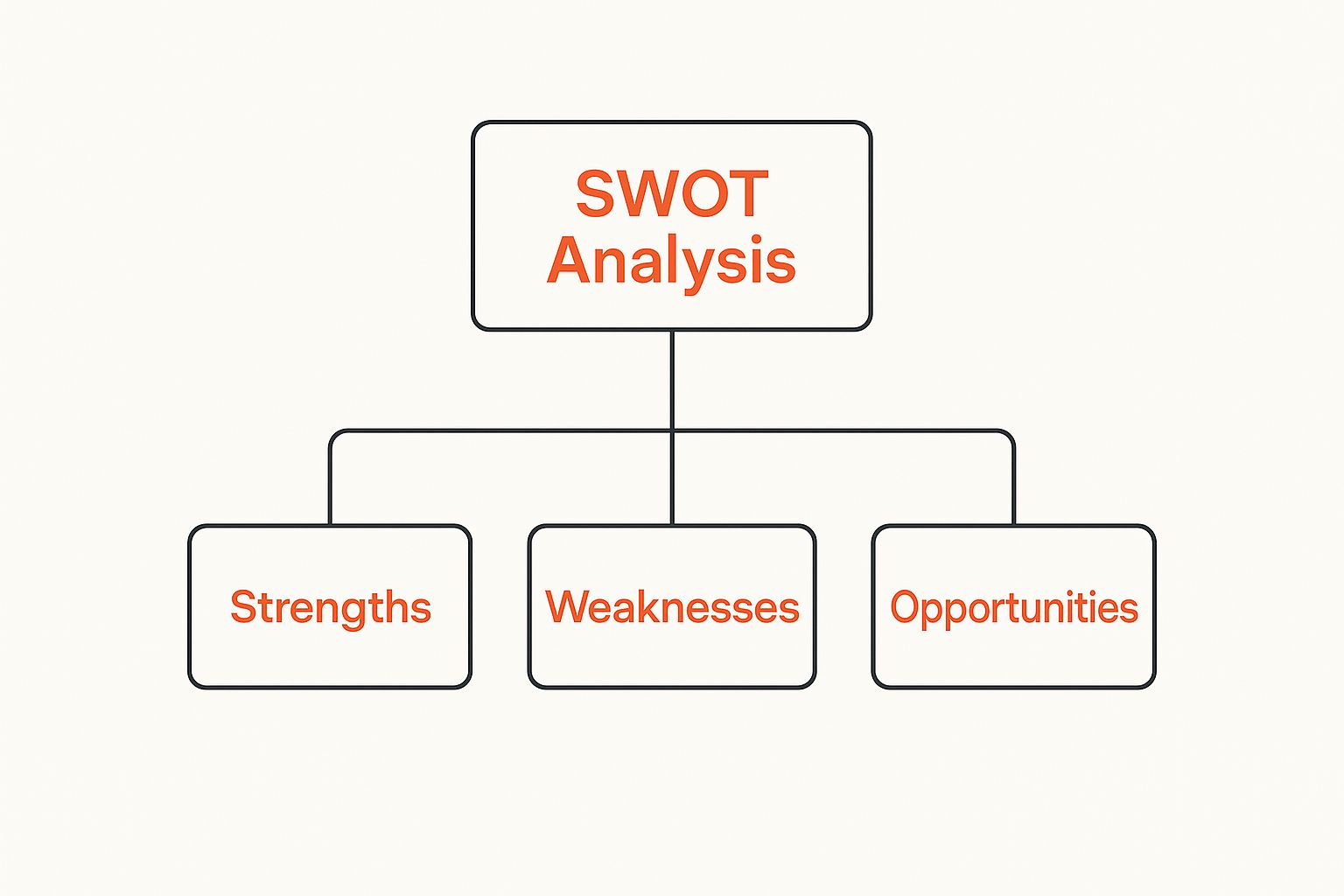A competitive landscape analysis is much more than just a list of your rivals. Think of it as your startup's strategic battle map—it shows you precisely where your competitors are strong, where their defenses are weak, and, most importantly, where the unclaimed market territory lies.
It’s the foundational work you do to identify who you're up against and dissect their strategies so you can carve out your own path to success.
Why This Battle Map Is Your Startup’s Most Important Asset
Staring at a new market can feel overwhelming, like looking at a vast, uncharted wilderness. A competitive landscape analysis is the map and compass that guides you through it. It's not just about knowing who's already there; it's about deeply understanding the entire ecosystem.
For a founder, indie hacker, or solopreneur, this isn't just some business school exercise. It's a survival tool. It’s the critical difference between launching straight into a bloody, saturated firefight and strategically finding a valuable, underserved niche you can own.
Pinpoint Your Strategic Position
Without a clear view of the competition, you're essentially building your product in the dark. A thorough analysis forces you to answer the tough questions that will ultimately shape your entire business:
- What really makes our solution different? This pushes you beyond vague claims to define a genuinely unique value proposition.
- Where are the actual gaps in the market? Instead of just copying features, you can spot real user pain points that everyone else is overlooking.
- How should we price our product? Understanding how others price their offerings gives you a baseline, allowing you to develop a strategy that reflects the unique value you provide.
- Which marketing channels are working? By seeing where rivals succeed (and fail), you can invest your limited time and money much more intelligently.
This process is about making informed, strategic bets that build a sustainable business, not just coasting on guesswork and hope.
Understand the Bigger Picture
Your direct competitors are only one piece of the puzzle. The real competitive landscape includes massive economic, technological, and societal shifts that affect everyone's ability to compete. This is even true on a global scale, where a country's competitiveness is about far more than its economic output alone.
For instance, the competitive landscape is increasingly shaped by digital readiness, economic resilience, and sustainable practices. The IMD World Competitiveness Ranking highlights this well. As of 2023, nations like Denmark, Ireland, and Switzerland lead not just because of their economies, but because they excel in areas like business efficiency and infrastructure. This proves that true competitiveness is a complex mix of institutional quality, human development, and productive agility.
For an indie hacker, this is a crucial insight. It means you need to think beyond simple feature-for-feature competition. The real opportunity might be in solving a niche problem that larger, slower players overlook because they’re too focused on broad market trends.
This table breaks down the essential elements you'll analyze to map your market environment effectively.
Key Components of Your Competitive Landscape Analysis
| Component | What It Reveals | Why It's Critical for Your Startup |
|---|---|---|
| Direct Competitors | Who offers a similar solution to the same target audience. | Helps you understand the immediate threats and baseline expectations in your market. |
| Indirect Competitors | Who solves the same problem but with a different solution or technology. | Uncovers alternative ways your customers are meeting their needs, which could be a bigger threat than you realize. |
| Market Positioning | How competitors present their brand, value, and pricing to customers. | Shows you where the "premium," "budget," and "niche" slots are, helping you find your own unique position. |
| Product & Features | The core functionalities and unique selling points of competing products. | Allows you to identify table-stakes features versus areas where you can innovate and differentiate. |
| Marketing & Sales | The channels, messaging, and tactics competitors use to attract and convert customers. | Provides a roadmap of what works (and what doesn't), saving you from reinventing the wheel with your own strategy. |
| Customer Sentiment | What real users love and hate about competitor products (found in reviews, social media, etc.). | This is a goldmine for identifying your competitors' weaknesses and finding opportunities to build something better. |
By breaking down the landscape into these components, you can move from a state of uncertainty to one of strategic clarity.
Ultimately, a competitive landscape analysis isn't a defensive chore you do once. It's an offensive strategy that empowers you to find your unique spot in the market, refine your product, and build a business with a real, durable advantage. It turns an intimidating, crowded market into a map filled with clear opportunities.
Identifying Your True Competitors Beyond the Obvious
It’s easy to get tunnel vision during a competitive analysis. Most businesses lock onto the rivals that look and feel just like them, the ones selling the same product to the same people. But while keeping tabs on your direct competitors is crucial, the real game-changing threats—and the biggest opportunities—often sneak up on you from unexpected places.
To build a strategy that can withstand market shifts, you have to look past the obvious.
Think of it this way: if you run a local shop selling premium, single-origin coffee beans, the other specialty roaster down the street is your direct competitor. That's clear. But what about Starbucks? They solve the same "I need a caffeine fix" problem, just with a different experience and product. They're an indirect competitor. Then there’s the high-end energy drink company. They solve that same core need with a completely different product—a substitute. If you ignore those last two, you’re operating with a dangerously incomplete picture of your market.

This wider perspective is becoming more critical every day. The competitive field is getting crowded and complex, with new players emerging from adjacent industries or different countries at a dizzying pace. As outlined in the full DNI report on global trends, we're in a dynamic where nimble businesses can pivot and enter new markets with surprising speed.
The Three Tiers of Competition
So, to make sure you don't get blindsided, your analysis needs to account for three distinct tiers of competitors. Each one poses a different kind of threat and calls for its own strategic response.
- Direct Competitors: These are the companies that first spring to mind. They offer a nearly identical product to your exact target audience, solving the same problem in a very similar way. For a project management tool like Trello, Asana is the textbook direct competitor.
- Indirect Competitors: These businesses solve the same core problem for the same audience, but they do it with a different type of solution. A great example for Trello would be a tool like Notion. While it isn't a dedicated project manager, its flexible, block-based system allows users to build their own custom project management workflows, effectively replacing the need for a tool like Trello.
- Potential or Substitute Competitors: Here are the wild cards. These are completely different products that can be jury-rigged to solve the customer's problem. They might also be companies in a nearby market that could easily pivot into your space. For Trello, a simple spreadsheet or even a basic to-do list app can be a substitute—the "good enough" solution that stops a customer from paying for a specialized tool.
Uncovering Competitors in the Wild
So where do you find these hidden rivals? It takes a bit of digital detective work. Your main goal is to put yourself in your customer's shoes and figure out what they search for when they aren't looking for you specifically.
- Go Beyond Basic Searches: Don’t just Google your own brand name. Use advanced search queries like
"alternative to [your product]"or"[your key feature] vs". These searches will uncover comparison articles and forum discussions that are packed with the names of your indirect and substitute competitors. - Mine Software Review Sites: Websites like G2, Capterra, and TrustRadius are absolute goldmines. When you look up your direct competitors, pay close attention to the "People Also Considered" and "Compare" sections. This is where you'll see the exact alternatives your real prospects are weighing.
- Dig into Communities and Forums: This is where you find the raw, unfiltered truth. For indie hackers and solopreneurs, Reddit is an incredible source of insight. People don't just talk about products; they describe their problems and frustrations in vivid detail. By manually sifting through subreddits like
r/saasorr/solopreneur, you can see how people are actually solving their problems today, often with clunky workarounds you'd never have considered competition.
This process of uncovering real user pain points is exactly what ProblemSifter automates. Instead of spending hours scrolling, it identifies real, unfiltered problems people are discussing on Reddit. It not only helps you with startup ideation but also reveals the "competitors" people are currently using—even if those competitors are just clunky spreadsheets or a combination of free tools.
By expanding your definition of a competitor, your analysis transforms from a simple checklist into a powerful strategic tool. It prepares you not just for the rivals you see today, but for the market shifts and substitute solutions that will define your business tomorrow.
Now that you’ve mapped out who your competitors are, the real work begins. It’s time to put on your detective hat and move from simply knowing who they are to understanding why they succeed or fail. This isn't just about listing rivals; it's about digging deep to collect intelligence that reveals their inner workings.
We’re talking about their pricing, core features, marketing channels, and—most importantly—what their actual customers are saying about them.
It's tempting to fall into the trap of creating a simple feature-for-feature checklist. Don't. That path leads to building a "me-too" product that doesn't stand out or solve a unique problem. The true goal here is to find the gaps in the market—the specific, nagging user pains that your competitors are either overlooking or failing to fix.
Listening to the Unfiltered Voice of the Customer
Forget marketing copy and glossy homepages. The most valuable intelligence you'll find comes directly from a competitor's customers. You need to find the digital watercoolers where people are having candid conversations about their frustrations, wish lists, and the clever workarounds they've invented.
These are the goldmines for raw, unfiltered insight:
- Customer Review Sites: Platforms like G2, Capterra, and Trustpilot are non-negotiable. Zero in on the 2- and 3-star reviews. These are often from users who wanted to love the product but couldn't, highlighting the exact feature gaps or usability nightmares that drove them away.
- Social Media and Forums: Comb through X (formerly Twitter), LinkedIn, and industry-specific forums. Search for phrases like "[Competitor Name] alternative," "I wish [Competitor Name] could," or "how do you solve [problem] without [tool]."
- Online Communities: Honestly, Reddit might be the single most powerful tool for an indie hacker. In subreddits like
r/saas,r/smallbusiness, or any niche community, users aren't just leaving reviews; they're describing their day-to-day business problems in excruciating detail.
This kind of manual research is priceless, but let's be real: it's a grind. You can easily burn days sifting through hundreds of comments just to find a single, actionable idea.
Your Secret Weapon for Finding Real Problems
For indie hackers and solopreneurs who need to move fast, there's a much more direct way to find these market gaps. This is where a specialized tool like ProblemSifter becomes a genuine secret weapon. Instead of you spending countless hours manually mining Reddit for ideas, it does the heavy lifting for you.
ProblemSifter was built for this exact purpose. It systematically analyzes discussions in key business and tech subreddits to pinpoint real, unfiltered problems that people are actively trying to solve. It bridges the chasm between knowing you need to do market research and actually finding a validated problem worth building a solution for. If you want to dive deeper into this process, check out our guide on how to do market research for a startup.
Here’s a glimpse of what its interface looks like, presenting curated problems straight from Reddit conversations.

As you can see, it's a clean dashboard that lists validated business problems, complete with context and a link back to the original source.
Unlike other tools, ProblemSifter doesn’t just suggest ideas—it connects you to the exact Reddit users asking for them. This is a total game-changer because it gives you not just the "what" (the problem) but also the "who"—your potential first customer.
Data Gathering Tools for Indie Hackers
As a solopreneur or a tiny startup, you're constantly fighting the clock and the budget. Picking the right tools to gather intelligence is absolutely critical. Here’s a quick comparison to help you choose wisely.
| Tool/Method | What It Gathers | Best For | Pricing Model |
|---|---|---|---|
| Manual Research | Customer reviews, social media mentions, forum posts. | Getting a deep, qualitative understanding on a zero budget. | Free (but costs you a ton of time). |
| Google Alerts | Mentions of competitor names, keywords, or industry trends. | Passively monitoring what competitors are up to. | Free. |
| Paid CI Platforms | Broad data on web traffic, ad spend, feature releases. | Well-funded teams needing quantitative market overviews. | Subscription (often $1,000+ per month). |
| ProblemSifter | Curated, validated user problems from Reddit. | Indie hackers who need validated startup ideas and their first customers. | Lifetime Access (One-time payment: $49 for 1 subreddit, $99 for 3). |
The difference is pretty stark. While big-gun competitive intelligence platforms are powerful, their monthly price tags are out of reach for most early-stage founders. ProblemSifter offers a laser-focused, affordable alternative. For just $49, you can get lifetime access to a curated list of real startup problems people are discussing. No subscriptions, no hidden fees—just a massive head start.
This approach flips competitive analysis from a reactive chore into a proactive strategy. You're no longer just charting what already exists; you're discovering what's missing and arming yourself with the direct user insight needed to build it.
Analyzing Competitor Data with Proven Frameworks
Once you've gathered your competitive intelligence, you’re often left staring at a mountain of raw data. You'll have spreadsheets of competitor features, notes on pricing tiers, customer complaints scraped from forums, and a folder full of marketing screenshots. On its own, this data is just noise. To turn it into a clear strategy that shows you exactly where to attack, you need a system.
Think of it like trying to assemble a piece of furniture. You can have all the screws, panels, and tools laid out on the floor, but without the instruction manual, all you really have is a messy pile of parts. Proven frameworks are your instruction manual—they give you a step-by-step process for turning all those components into a coherent, functional strategy.
Use SWOT Analysis to Map Your Position
The SWOT analysis is a classic for a reason: it’s simple, effective, and forces you to be brutally honest about where you stand. It’s a framework that prompts you to evaluate four key areas.
- Strengths: These are your internal advantages. What do you genuinely do better than anyone else in your space?
- Weaknesses: These are your internal limitations. Where do your competitors consistently leave you in the dust?
- Opportunities: These are external factors you can jump on. What market gaps, new technologies, or user frustrations can you address?
- Threats: These are external factors that could sink you. What are your rivals doing that could make your solution less relevant tomorrow?
The real magic happens when you connect your internal reality (Strengths, Weaknesses) to the external landscape (Opportunities, Threats). For instance, a competitor's glaring Weakness—like their notoriously bad customer support—can become your golden Opportunity, especially if providing excellent support is already one of your core Strengths.

This diagram neatly shows how your internal capabilities directly connect to the external market environment, which is crucial for guiding your strategic focus.
Build a Feature Comparison Matrix to Find Gaps
While SWOT gives you the 30,000-foot view, a Feature Comparison Matrix zooms in on the nitty-gritty details of the products themselves. It's a surprisingly powerful table that lets you visually map your product's features right alongside your competitors'.
The process is refreshingly straightforward:
- List all the relevant product features you can think of down the first column.
- Put your company and your key competitors across the top row.
- Go through and fill in the grid. You can use a simple checkmark, a 1-5 rating, or a short note to show how well each competitor delivers on a specific feature.
This isn't just about playing copycat or feature-chasing. The real goal here is to spot the patterns. You're hunting for the rows that are mostly empty or filled with notes like "buggy" or "poorly implemented." Those are your feature gaps—the underserved areas where you can innovate and build something that is demonstrably better.
For indie hackers and lean startups, this hunt for underserved needs is the very lifeblood of a new venture. But manually combing through Reddit threads and product reviews to find these gaps can be a soul-crushing time sink. This is where a tool like ProblemSifter can give you a massive shortcut. It automatically surfaces these "feature gaps" that people are actively complaining about on Reddit, handing you a pre-validated list of opportunities.
Unlike other tools, ProblemSifter doesn’t just spit out generic ideas—it connects you to the actual Reddit users asking for these solutions. You can learn more by checking out our guide on conducting market research.
For a one-time fee of just $49, you get lifetime access to a curated feed of real startup problems people are talking about right now. It’s an incredibly efficient way to populate your feature matrix with insights grounded in real user pain, not just your own assumptions. By combining a systematic framework with smart, data-driven tools, you can finally turn that messy pile of information into a clear roadmap for building a product that wins.
Translating Your Analysis Into a Winning Strategy
An analysis is just a document until you do something with it. You’ve put in the work—gathering data, mapping out the competition, and filling in the frameworks. Now comes the critical part: turning all that knowledge into a real-world strategy that carves out your own spot in the market.
This is where your research graduates from a simple report to a strategic playbook. The whole point isn't just to know what your competitors are doing, but to figure out what you will do differently—and better. It’s all about building a unique value proposition that solves a real, unmet need.

Refine Your Product Roadmap with Precision
That feature comparison matrix you built? It's not just a checklist; it's a treasure map. The gaps you found—the features competitors either lack or execute poorly—are your biggest opportunities. Use these insights to prioritize your product roadmap with brutal efficiency.
Instead of just copying every new feature your rival launches, you can now focus on what truly matters:
- Solving Overlooked Pains: Prioritize the features that directly fix the user complaints you uncovered. If you found a dozen Reddit threads complaining about a competitor’s confusing interface, making your user experience seamless should be your top priority.
- Building Your "Wedge": Double down on the one thing you can do 10x better than anyone else. This becomes your strategic wedge, the sharp point you use to break into the market.
- Ignoring the Noise: Your analysis gives you the confidence to say "no." You can now confidently de-prioritize features that are just "nice-to-haves" or that serve a customer segment you have no intention of targeting.
Craft Marketing Messages That Hit Competitor Weaknesses
Your competitive analysis is a goldmine for writing marketing copy that actually works. You know exactly where your competitors are letting their customers down. This is powerful information you can use to position your solution as the only logical choice.
Turn their weaknesses into your strengths. If customers complain about a competitor's hidden fees and confusing subscription tiers, make your simple, transparent pricing a cornerstone of your messaging.
This direct approach helps you attract frustrated customers who are already looking for something better. Understanding what drives people away from rivals is a core part of learning how to find your target audience and speaking their language.
Set Pricing That Reflects Your Unique Value
Pricing isn't just about matching what others charge; it's a statement about your strategic position in the market. With a solid analysis in hand, you can stop copying competitor price tags and start setting a price that aligns with the unique value you deliver.
Are you competing with a single, killer feature that saves users hours every week? Your price can reflect that high value. Are you focused on a niche market that everyone else has ignored? You have the freedom to set a whole new pricing benchmark.
This strategic thinking is vital, especially as markets face more scrutiny. The OECD Competition Trends 2025 report, for instance, notes a global increase in resources for competition authorities. This shows that having a clear, defensible value proposition is more critical than ever.
Close the Loop with Hyper-Targeted Outreach
For indie hackers and solopreneurs, this is where the strategy gets incredibly effective. The analysis isn't finished once the product is built—in fact, it’s the very beginning of your go-to-market plan.
Remember those Reddit threads you found? The ones with specific usernames where people were practically begging for a solution to the exact problem you just solved? It's time to go back to them.
This creates a powerful, hyper-targeted launch strategy:
- Ideate: Find a validated pain point with a tool like ProblemSifter.
- Build: Create a solution that directly addresses that pain.
- Promote: Return to the original posts and engage directly with the users who expressed the need in the first place—a process that ProblemSifter facilitates by providing the original post and usernames.
This approach lets you bypass expensive, spray-and-pray marketing and connect directly with your first potential customers, turning your initial research into a direct line for customer acquisition.
Frequently Asked Questions About Competitive Analysis
It’s easy to get tangled up in the details of a competitive landscape analysis, but it's one of the most powerful things you can do for your business. Let's clear up some of the most common questions I hear from founders, makers, and solopreneurs.
How Often Should I Update My Competitive Analysis?
Think of your competitive analysis as a living, breathing document, not a one-and-done report you file away. For a startup in a dynamic space like SaaS, a major deep dive once a year is a solid baseline. Then, do a lighter 'pulse check' every quarter to keep things fresh.
That said, some events should trigger an immediate, full-scale review, no matter where you are in that cycle. These include:
- A new, well-funded competitor suddenly appears on the scene.
- A major technological shift happens (like a new AI model) that could change the game.
- One of your main rivals drastically changes their pricing.
- You're about to make a big strategic pivot or launch a new product.
Staying on top of these moments ensures your strategy is grounded in reality, not outdated assumptions. You'll never be caught flat-footed by a market shift.
What Is the Biggest Mistake to Avoid in Competitor Analysis?
By far, the most dangerous trap is 'feature chasing'. It's that knee-jerk reaction to copy every single new feature your competitor rolls out. This path is a dead end. You'll always be playing catch-up, and you'll end up with a bloated, "me-too" product that has no soul or unique selling proposition.
A truly powerful analysis isn't about the competitor's solution; it's about the customer's problem.
Instead of asking, "What features do they have?" you need to be asking, "What critical customer pain points are they failing to solve?" This simple shift in mindset is the difference between building a cheap imitation and building a category-defining product.
This is exactly why tools built for startup ideation can be so helpful. For instance, a platform like ProblemSifter is designed to anchor your research in real, documented user problems. It helps you sidestep the feature-chasing trap by forcing you to focus on what the market is actually crying out for, not just what your rivals are building.
Can I Do a Good Analysis with a Zero Budget?
Absolutely. While paid competitive intelligence tools are great for speed and scale, you can absolutely conduct a thorough and effective analysis without spending a dime. Your main investment will be your time and focus, not your wallet.
Here’s how a scrappy founder can gather top-tier intelligence for free:
- Advanced Google Searches: Get creative with search operators like
"alternative to [Competitor]"or"[Problem]" + "frustrating"to find comparison articles and deep-cut forum discussions. - Review Mining: Methodically sift through the 2- and 3-star reviews for your competitors on sites like G2 and Capterra. This is where you’ll strike gold—the unfiltered truth about their biggest weaknesses.
- Community Immersion: Dive into forums like Reddit. Find the subreddits where your potential customers hang out. These are treasure troves of candid feedback, complaints, and creative workarounds.
Of course, this manual approach takes a ton of time. For founders who know that speed is a competitive advantage, a small, strategic investment can save you from hundreds of hours of grunt work.
This is the sweet spot for a tool like ProblemSifter. For a one-time payment of just $49 for 1 subreddit or $99 for 3, you get lifetime access to a curated list of real startup problems people are openly discussing on Reddit. It connects you directly to the original posts and usernames of people feeling the pain, giving you an incredible head start.
How Do I Analyze Competitors in an Unfamiliar Niche?
Jumping into a new niche can feel daunting, but it also gives you an incredible advantage: a fresh perspective. The trick is to become a student of the customer before you become a student of the competition.
Your first job is to immerse yourself completely in your target audience's world.
- Learn Their Language: Use keyword research tools to find the exact phrases and questions people are using to describe their problems. This is how you learn to speak the language of the niche.
- Read the Industry News: Start following the key blogs and publications in the space. You'll quickly get a sense of who the major players are and what topics dominate the conversation.
- Become a Digital Eavesdropper: This is the most important step. Spend serious time lurking in online communities like Reddit where your audience gathers. Don't just skim—read their detailed questions, their frustrated rants, and their wish lists for better solutions.
This "digital eavesdropping" method is the fastest way to understand the competitive landscape from the only perspective that matters: the customer's. Unlike other tools, ProblemSifter doesn’t just give you ideas—it links you to the exact Reddit users asking for them, making it the perfect tool for validating your ideas and finding your first customers in any niche.
Ready to stop guessing and start solving real problems? ProblemSifter turns Reddit into your personal idea engine, surfacing validated pain points so you can build what people actually want. Get a massive head start on your competitive analysis and go-to-market strategy. Check out ProblemSifter today!
